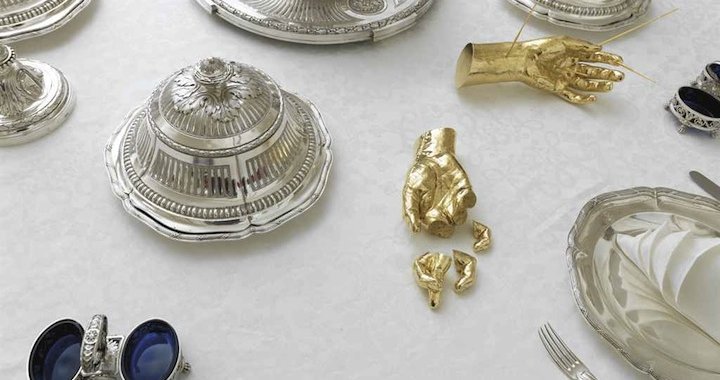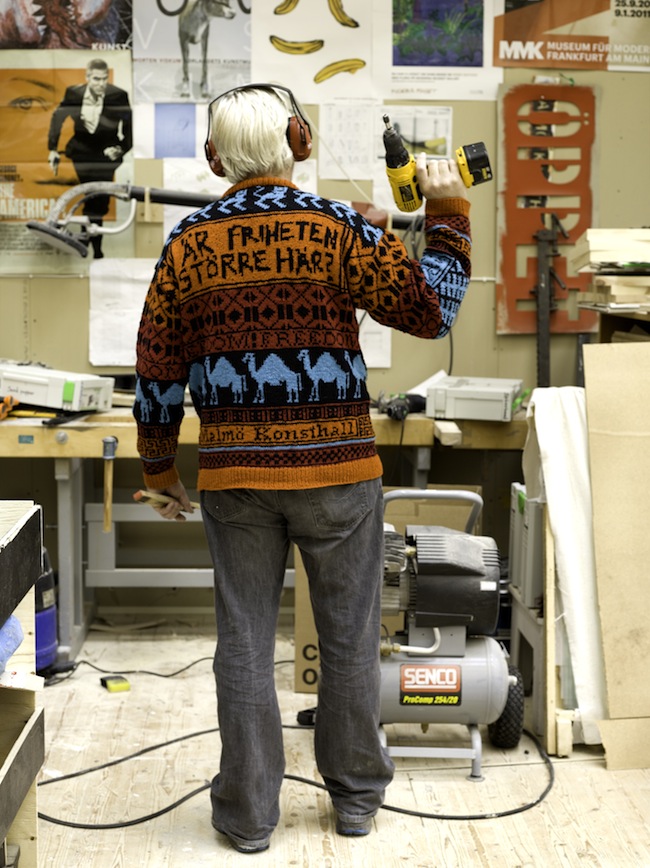
Where are the “Golden Hands”?
13/12/2012
At the end of November, the international press came out with the news of a robbery that had taken place at one of the world's most respectable auction houses – London's Christie's. A sculpture depicting a golden hand – The Left Hand and the Right Hand Have Left One Another (2007), by Scottish artist Douglas Gordon – was discovered missing from the auction house's warehouse. While moving boxes, a warehouse worker noticed that one box was suspiciously light in weight; upon inspection, it was found that the box was empty.
This unfortunate incident, which is still shrouded in confusion, can be used to illustrate a situation in the art world which surfaces periodically: namely, the notion that the artist's “golden hands” really are disappearing – that technical expertise is no longer the primary qualification for creating highly regarded works of art. The quality of the end product is not at issue here, but rather the issue of authorship. A large number of today's top-selling artists generate ideas and then supervise the execution of these ideas, with the result being that the “golden hands” no longer belong to the artists, but rather to the artists' employees. This situation is not unprecedented, by any means – for example, Takasi Murakami's studio, Kaikai Kiki Co, was established in 2001 (which, in turn, evolved from the Hiropon Factory in the 1990's). And let's not forget Andy Warhol's Factory, which was in operation from the 1960's to the 80's.
Meanwhile, the concept of what it means to be an artist in the 21st century is changing much more slowly; it is not for naught that Damien Hirst's approach to his profession (do-not-do-it-yourself) is often denounced. In their 2012 research paper, Large Scale Art Fabrication and the Currency of Attention, Karen van den Berg and Ursula Pasero suggest a need for reevaluating the issue of authorship and professionalism at a time when the world's brightest artists spend most of their time managing worker groups. But let's not get too hasty here. In an effort to unravel this knot in which the whole art scene appears to be tied-up in, it is worth mentioning an exhibition this summer at the Prado Museum in Madrid, which was organized in cooperation with the Louvre. In the exhibition “Raphael”, attention was focused on the famous Renaissance painter who, interestingly enough, had approximately fifty assistants working in his workshop. At the time, having such a large number of apprentices was extremely unusual. The workshop worked with not only paintings, but also architecture, tapestry sketches, and even archeological research studies. As the curators of the exhibition pointed out, the wish to work cooperatively was a very marked characteristic of Raphael, and thereby challenges the usual concept of an art work being a solo project (although Raphael did create a great number of paintings by himself).
The exceptional 16th century painter was endowed with both a powerful aesthetic vision and the capacity to amicably, but strictly, control the quality of the work under his supervision. (This brings to mind the documentary film about Chinese dissident artist Ai Weiwei (Ai Weiwei: Never Sorry, 2012), who, upon receiving his almost-two-meter-high porcelain vases from the factory, brutally smashes every vase that doesn't adhere to his vision. This is how Weiwei marks his role as “the artist” in this kind of artistic model – by defining the destruction as a sort of self-punishment that is necessary if standards are to be maintained.) As the Enlightenment-era German philosopher, publicist and art critic, Lessing, wrote in his day – Raphael would have been a genius painter even if he had arrived on this earth lacking both arms. But even if history does take a spiral form, is it true that, at the elite-level of contemporary art, the “golden hands” will become ever more the responsibility of the executioner, while the artist will revert to just “giving birth” to his/her “golden ideas”?
Just this last November, an article in The Art Newspaper sketched out a new trend in the art market in which there is a palpable weariness of this sort of “fabricated” art. It is still much too early to call this a paradigm shift, but nevertheless, collectors have been noticeably acting more prudently in an attempt to separate the seed from the chaff. The article uses as an example American artist Fred Tomaselli's 2005 piece, Organism – a pedantically arranged collage of photographs and paint, all mounted on a wooden panel. It is believed that a video on Youtube, that shows how Tomaselli created the piece, played a large part in the work of art being sold at Christie's this last October for the winning bid of 735,650 British pounds – an amount considerably higher than expected. “Originality and uniqueness are qualities that are still highly valued in the field of art,” write Van den Berg and Pasero. Even Damien Hirst surprised (and amused) the art world this spring when, instead of dead animals, odd sculptures or more “dot” paintings, he came out with a series of paintings titled Two Weeks One Summer; Hirst stressed that he had done the slightly-surreal paintings himself, in his studio in Devon. Regardless, Hirst was still put down by the critics, who unabashedly pointed out that “that ship has already sailed” – in case the artist was thinking of going back in time to his youth, to become a painter.
In contemporary art – where one extreme provokes other, completely opposite extremes – uniformity and industrial production has spurred many artists to include meticulous handwork into their daily routines. While theorists try to draw and figure out the length of the fuzzy line that separates art from craft, Tracy Emin embroiders, the eccentric Grayson Perry works with clay and weaves provocative themes together with hobby art, and the Dutch artist Michael Raedeker “paints” with staples. And these are just a few examples. It was in this context that a large group show devoted to the love of artisanship, Lovecraft, was exhibited in London in 1998.
“The current neo-craft trend appeals to many artists because it is surrounded by a certain aura of anonymity; this sort of work or practice is not centered on the ego, and it allows for the return to a known tradition and order,” explains Zane Onckule, director of the kim? Contemporary Art Centre in Riga.

Lisa Anne Auerbach. Freedom, 2012. With Magnus Ólafsson. Photo: Lisa Anne Auerbach
A shining example is on view right now – through January 27, 2013, the Malmö Konsthall in Sweden is showing American artist Lisa Anne Auerbach's solo exhibition, Chicken Strikken. The exhibition doesn't fill an art hall the way one would expect. The show consists of 25 pieces, all of which are knitted sweaters – and they will be worn by the Malmö Konsthall staff. Auerbach has worked with knitting as a contemporary art technique for a long time. The pattern and writing on each sweater has been individually customized to every staff member's personality and interests. When asked about the division between art and craft, Auerbach says (in her video interview with Arterritory.com) that it is very hard for her to point out differences – because both areas blend together in the work process. She does attest, however, that craft is more connected to a tradition that has been handed down, whereas art is more concerned with creating something new.
“If you think of very traditional types of craft, you could say that it was lost a while ago. Yet it still pops up through the individual artists’ work,” explains Jacob Fabricius, the director of Malmö Konsthall. “Some artists might do everything themselves but most outsource the physical work (to be done by fabricators). At the same time everything is still mixed into the esthetical work and practice of each artist.” But Laura Rutkutė, the art director of a Lithuanian art gallery Galerija Vartai, believes that “craft skills were and still are very important for contemporary artists as they have to be able to request and get the results they desire, when employing crafts professionals to produce their work.”
In thinking about the possible situation in 2022, van den Berg and Pasero forecast that this turning towards handcrafts will become ever stronger, and not only in the field of art. Three years ago, the American philosopher Matthew Crawford came out with the book, The Case for Working with Your Hands, in which he expounds on his belief that doing practical work with our hands can make us happier. In 2000, Crawford received his doctorate in political philosophy, but after just a year, began to work on motorcycle restoration. But returning to predictions for the future of art, van den Berg and Pasero maintain that it is unlikely that the now-widespread profession of “art fabricator”, or rather, masters of various handcrafts whose job it is to execute the ideas of the artist, will disappear. It is only the respective weight of influence of both parties that will change.
“There are artists who, through the use of applied art in their practice, either directly or indirectly bring across their political stance in terms of this digital, post-medium era. But in direct contradiction to traditional handcrafts, “high art” is allowed to have an exciting flirtation with amateurish artisanship,” states Zane Onckule.
In an essay on the primitive and the professional, in which “the primitive” is a favorable label for those artists who work outside of established conventions, the cultural historian John Berger writes: “… the “clumsiness” of primitive art is the precondition of its eloquence. What it is saying could never be said with any ready-made skills. For what it is saying was never meant, according to the cultural class system, to be said.” Needless to say, with Christmas approaching, a unique hand-made object has a very meaningful and hard-to-define added value – it comes from the heart.